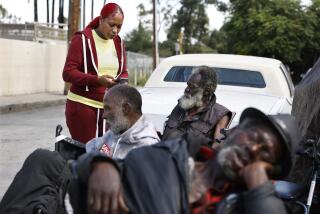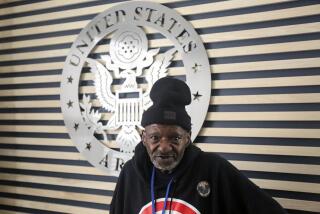VISTA Presses on With Altered Mandate
- Share via
WASHINGTON — VISTA volunteer Geraldine Bond bears no resemblance to the bright-eyed, middle-class students who left college and fanned out over the country to fight poverty 20 years ago when Congress established Volunteers in Service to America as the domestic equivalent of the Peace Corps.
But this is 1985, the fifth year of the Reagan Administration, and Bond, a 41-year-old housewife with five grown children who is doing volunteer work for disadvantaged children in Decatur, Ill., fits right in.
She works in her own community. Like half of today’s volunteers, she’s black. Like 55% of them, she’s over 35. But like the college kids of 20 years ago, she has an idealist’s view of the recreation and tutoring programs she is working on. “It’s a wonderful way to build self-esteem in youth,” she says. “I’m so glad I got this chance.”
VISTA has been transformed by four years of battling over its very existence. The Reagan Administration, having failed to abolish it, has succeeded in converting it from a center of young social activists to an organization of somewhat older, mostly minority and predominantly low-income volunteers who are trying to serve the people they live with.
Carter Approach Told
Under President Jimmy Carter, VISTA intentionally supplied volunteers to organizations that sought to “empower the poor” by organizing communities, providing legal aid and advising the poor of their rights as tenants and welfare recipients.
To the newly installed Reagan Administration in 1981, VISTA had become an instrument of left-wing political activism. President Reagan appointed Thomas W. Pauken to succeed Sam Brown, a former anti-Vietnam War activist, as director of ACTION, the government’s umbrella volunteer agency, and Pauken promptly and repeatedly asked Congress to abolish VISTA.
Although Congress insisted on keeping VISTA alive, it cut its budget from $34 million in 1981 to $11.8 million in 1983. The staff was slashed. National recruitment stopped. Total volunteers nationwide dropped from 4,100 in 1981 to 930 in 1984. VISTA had five directors in four years. “Confrontational” activity by volunteers was banned. The director in Washington scrutinized every project application.
Shift of Focus Detected
Pauken’s critics say he did not remove VISTA from politics, as he claims, but simply shifted its politics. They point to the case of the VISTA volunteers working for the Boston office of Birthright Inc., which counsels pregnant women not to get abortions.
Pauken says those volunteers do no counseling but merely help find food, jobs and shelter for women who have already decided against abortions. But VISTA was embroiled in controversy in late January when a Washington staff member--without authorization--sent a letter to Birthright chapters all over the country urging them to apply for volunteers.
This year for the first time, the Administration is seeking not to annihilate VISTA but only to hold its 1986 budget to $17 million, its current level.
Peter Heinaru, California state ACTION director, says he expects to have 200 VISTA volunteers working in California by Sept. 30, up from 100 today.
Paid $400 a Month
VISTA volunteers, like those of the Peace Corps, are paid. A volunteer spends a year working full-time for a nonprofit organization for about $400 a month, plus health insurance, and a $950 grubstake when the year is up.
The idea is that those who could not afford to put in that kind of time for free can do it at subsistence wages. “It keeps my life simple,” said Danny Barutta, 28, a San Francisco volunteer.
Like the Peace Corps, VISTA used to collect recruits all over the country, train them for six weeks and dispatch them to nonprofit groups. But now that VISTA has no funds for training and transportation; all that is up to the groups that intend to use the volunteers.
Now sponsors can choose their own volunteers, and some in the program contend that sponsors are now finding people with a better understanding of their communities’ needs.
In San Francisco, for example, some of the volunteers who shelter and counsel runaway teen-agers at the Diamond Street Youth Center come, like the kids, from the gay community and the punk scene. Volunteer Stephanie Demaria, 42, thinks that’s crucial to the center’s success.
Cambodian Among Volunteers
And in San Jose, Sary Pann, 37, who helps refugees at the Indochinese Resettlement and Cultural Center, is a Cambodian exile himself. As a prospective social worker, he has a shrewd idea of what VISTA can do for him. “You can help your own people,” he said, “and at the same time improve your English and your career skills.”
If Pann can use his experience with VISTA to improve his job prospects, he will not be the first. Carylon Brown of the Esquire Boys and Girls Club in South-Central Los Angeles says VISTA has provided important job training for her volunteers, many of them welfare mothers with children in the club, and two recent volunteers have gone on to study personnel management and child development. “It’s given them the self-respect of a reward for working,” she said.
Not everybody thinks VISTA should be a “modified Job Corps” for the unskilled. In the field, VISTA staff members and sponsors of VISTA volunteers agree that people who volunteer simply because they can’t get a job are not of much use.
Numbers Cut Down
The economic recovery has cut down on the number of volunteers looking for a regular, if not very sizable, paycheck. “We’re attracting more idealistic people again,” said Heinaru, California’s ACTION director.
What is not changing is VISTA’s new orientation under the Reagan Administration.
During the Carter Administration, a VISTA staff member recalled, project applications that were too “mild-mannered” were turned down; to start a day care center, applicants had to say they were going to “organize the community to demand better day care.” Today, she said, the staff tells groups that have “justice” or “coalition” or “rights” in their names not to bother applying.
More to Read
Sign up for Essential California
The most important California stories and recommendations in your inbox every morning.
You may occasionally receive promotional content from the Los Angeles Times.










